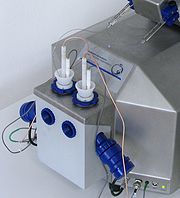O2k-TPP+ ISE-Module
| Description | O2k-TPP+ ISE-Module: 2 potentiometric ion-selective electrodes (ISE), ISE-Service Kit and 2 PVDF-Stoppers, supported by the O2k-Core. |
|---|---|
| Product ID | 12300-01 |
| Type | O2k, O2k-Module, MultiSensor, Stopper, Catalogue |
| Link | [[[MiPNet15.03_O2k-MultiSensor-ISE|ISE-Manual]], Tetraphenylphosphonium |
| Image |
O2k-TPP+ ISE-Module consists of:
The query description has an empty condition.
General
The OROBOROS ISE system is designed with replaceable membranes making it possible to measure different ions such as TPP+ or Ca2+ with the same electrode housing.
O2k signal and output
- O2k signal: The O2k-TPP+ ISE-Module is operated through the pX channel of the O2k, with electric potential (volt [V]) as the primary and raw signal
- O2k output: type C
O2k-Core and O2k Series A-E
For the O2k Series A-E, the O2k-TPP+ ISE-Module is supported by the O2k-Core and by all O2k instruments with the O2k-MultiSensor electronic upgrade.
TPP /TPMP electrode
The main purpose of the O2k-TPP+ ISE-Module is to measure Mitochondrial membrane potential via the TPP or TPMP method.
The first publication using the O2k-TPP+ ISE-Module for this purpose was Brown 2011 Am J Physiol Regul Integr Comp Physiol
Calibration of the TPP electrode
Data export and linear calibration
Mark stable sections on the pX raw signal, use or create a template of mark names, and copy to clipboard in Marks Statistics [F2]. Copy into an Excel template for TPP+ calibration. This template can be modified according to the specific calibration experiment (titration volumes, concentrations, number of data points, …). Perform a linear regression of the pX raw signal as a function of the log10 (analyte concentration). For highest accuracy, only the concentration range used in the final experiment should be included in the regression. The Excel template provides information on the regression parameter, R2, and by the deviation of data points from the regression (the residuals), and can be adjusted to specific calibration regimes.
From the O2k-MultiSensor menu the MultiSensor calibration window [Ctrl+F5] is opened MiPNet12.08 for a simple two-point linear calibration of pX (or –pX) as a function of recorded voltage, using known pX values.
Calcium electrode
General
The OROBOROS ion selective electrode (ISE) is designed with replaceable membranes making it possible to measure different ions such as Ca2+, TPP+, TPMP+ with the same electrode housing. See also Calcium for general consideration about Ca2+ measurements. We recommend to use fluorescence methods for measuring Ca2+ concentrations, utilizing the O2k-Fluo_LED2-Module. However, there may be special applications in which determination of Ca2+ levels via ISE is advantageous. The use of a Ca2+ electrode in mitochondrial research was described by Moreno et al.[1] Laboratories who are using the O2k-TPP+ ISE-Module (but who do not have the O2k-Fluo_LED2-Module) may apply the ISE for Ca2+ detection. ISE-Ca2+ Membranes are not included in the O2k-TPP+ ISE-Module but can be ordered from OROBOROS INSTRUMENTS separately (Product ID 42280-01), for application of the O2k-TPP+ ISE-Module for Ca2+ measurements.
Inner filling solution
The following inner filling solution is used: CaCl2: 10 mM
EDTA: 50 mM
pH adjusted to 8.5 with KOH
Conditioning
Conditioning of the membrane is a controversial topic. If any conditioning is done, the used free Ca2+ concentration should probable not be much higher than the highest expected concentration during applications of the electrode.
Calibration
As a potentiometric method, the Ca2+ electrode delivers a signal that is (in the working range) linear to the logarithm of the free Ca2+ concentration. Therefore, the electrode is calibrated by plotting electrode signal vs. logarithm of the free Ca2+ concentration. Calibration of the Ca2+ electrode at low (< 1µM) Ca2+ levels is typically done by exposing the electrode to a series of Ca2+ calibration buffers. For a discussion of Ca2+ calibration buffers see Calcium#Ca2.2B_calibration.
- Calculation of free Ca2+ concentrations:» Calcium#Calculation_of_free_Ca2.2B_concentrations
Technical service for the ISE system
In case of problems please follow first the suggestions in the chapter "Trouble shooting" of the manual. Below are some further options that may help if the procedures described in the manual were already tried. Sometimes it is difficult to find out whether problems with the ISE system are caused by the electrodes (TPP, Ca, reference, pH) or by the pX electronics of the O2k. The following tests can help to solve this question.
Testing a TPP system outside the O2k-Chamber
This test allows to test for any disturbing influences in the chamber, like crosstalk to the OroboPOS. It is therefore similar to the test proposed in the manual (switching off the O2 polarization voltages) but has a broader scope (covering also e.g. possible interference from stirrers) and provides a more complete separation of POS an pX electrodes.
Place TPP electrode and reference electrode together in one falcon tube filled with electrolyte solution (e.g. media). Connect the cables of the electrodes to the O2k and record the pX signal. If a problem previously observed disappears in this test (and is reproducible by using the same electrodes in the O2k-Chamber) the problem is located in the chamber, e.g. at a leaky POS membrane, see the manual.
Testing a TPP system with a pH electrode (and vice versa)
This method allows to test the sensitivity of the pX electronics.
Requirements
Another type of electrode than can be connected to the ISE system. So if the problem is observed with an ISE system for measuring TPP, a pH electrode is the usual choice because it is available in many labs. The only requirements for the second electrode is that it can be connected via a BNC port. It does not have to be an electrode from OROBOROS Instruments neither is it necessary that the electrode fits into the O2k chamber. However, note that using a pH electrode outside the O2k-Chamber also constitutes a test similar to the one described above (Testing a TPP system outside the O2k-Chamber). Therefore a problem caused e.g. by a leaky POS membrane will not be observed when testing with a pH electrode outside the chamber.
Procedure
- Connect the pH electrode to the oxygraph.
- Put the electrode into a pH 4 calibration buffer (event)
- Observe (record) the signal in DatLab.
- Put the electrode into a pH 7 calibration buffer (event). Obviously the sequence of buffers does not matter.
- From such a DatLab file we will see whether the pX electronics is working and even get a very rough estimation of the gain.
Testing TPP or pH electrodes with a voltmeter
This test measures the performance of the electrodes independently form the pX electronics of the O2k.
Requirements
Any voltmeter, frequently labeled "Multimeter" if different measurement modes can be selected, suitable for measuring mV potentials. .
Procedure for TPP electrodes
- Set up the TPP /reference electrode in the O2k chamber as usually, only medium in the chamber.
- Connect the electrodes to the pX electronics and record the signal.
- Disconnect both electrode cables from the O2k (but leave the electrodes in the chamber, stirring still on).
- If you have a "Multimeter" available set in into "Voltmeter mode"
- Set the recording range of the voltmeter to a range good for recording about 200 mV
- now measure the voltage difference between reference electrode and TPP electrode by touching (ideally fixing) the two probes of the voltmeter to the ends of the cables from the electrodes: for the reference electrodes this is simply the gold colored pin, for the TPP electrode this is the INNER , central pin. Note down the voltage reading on the voltmeter display. For this step the help of a second person is most convenient, otherwise you probable have to find a way to fix the cables in some way. It is not necessary to have the voltmeter in contact with the electrodes all the time, just when you are reading the values.
- Increase the TPP concentration in a few (lets say 5) rather large steps (at least 2 µM per step) and note down the displayed values.
- Finally reconnect the electrodes to the pX electronics of the O2k and observe how much (if at all) the signal has changed there. * Please send us the recorded values along with the TPP concentrations used and the the DatLab file recorded at the same time (that shows the readings for the first and last point). If no change in signal is visible with the voltmeter, the problem is at the TPP electrode, not the O2k.
Procedure for pH electrodes
- Follow the procedure for TPP electrodes, moving the pH electrode between different pH calibration buffers instead of doing a TPP titration.
References
- ↑ Moreno AJM, Vicente JA (2012) Use of a calcium-sensitive electrode for studies on mitochondrial calcium transport. Methods Mol Biol 810:207-17.






